How and how to make a branch from the wire?
Jim nut
When we considered the main methods for connecting wires in a junction box, special attention was paid to a special nut-type clamp. The product has a fairly simple design, but, despite this, it makes the branch reliable and durable. The compression nut consists of a carbolite body, a steel plate and a plate, which actually presses the cores with four screws.
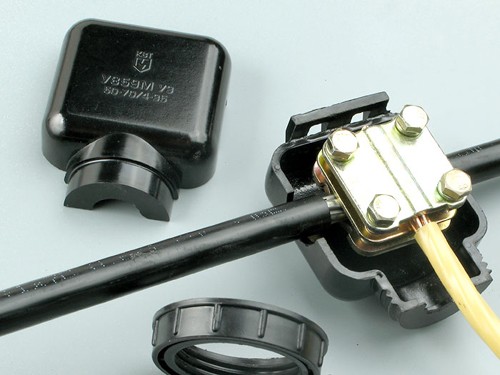 The compact size of the nut, as well as its low cost, makes it one of the most popular taps for the power line. In turn, the disadvantages of the product is low tightness (IP degree of protection 20), as well as the lack of the possibility of branching the conductors of wires under voltage. It should also be noted that a very important advantage of the "nut" is the ability to qualitatively connect copper and aluminum conductors with a cross section of 1.5 to 150 mm2.
The compact size of the nut, as well as its low cost, makes it one of the most popular taps for the power line. In turn, the disadvantages of the product is low tightness (IP degree of protection 20), as well as the lack of the possibility of branching the conductors of wires under voltage. It should also be noted that a very important advantage of the "nut" is the ability to qualitatively connect copper and aluminum conductors with a cross section of 1.5 to 150 mm2.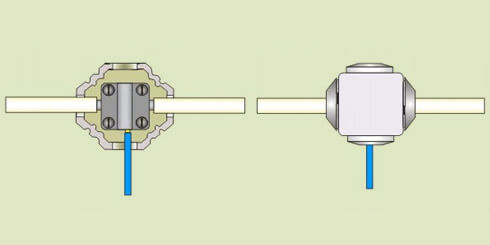
All you need to do is put the stripped contacts in a special plate and carefully tighten the screws with a screwdriver, and then snap the case into place. More about nut type You can find out from our article.
Piercing clamps
An improved model of cable grip nut are piercing clamps. Disposable products, however, allow you to branch the wire without cutting and even without removing the insulating layer when spliced. The clamp design is represented by a hexagonal head that tightens the cores, as well as contact plates with teeth, which actually pierce the insulating material.
They are most often used for branching from an air line laid SIP wire without stress relief.
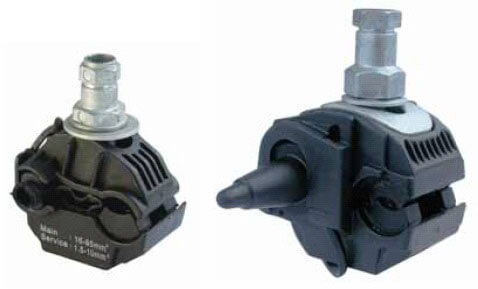 The advantage of these products is as follows:
The advantage of these products is as follows:
- You can branch wires from the overhead line (OHL) even when energized, without fear for your safety. This is due to the fact that the contact plate is reliably insulated from the clamping bolts.
- The body of the products is sealed and reliably protects the junction from bad weather conditions.
- The clamps are easy to operate and have a long service life.
- Low cost of production.
- Possibility of fastening copper and aluminum conductors.
As for the shortcomings, the main thing is only the “disposability” of the products, but this is a very controversial point, given the durability of this method of branching the wires without breaking.
Installation is as follows:
OV type clamp
When repairing or replacing electrical wiring in an apartment, you can use another pretty good option for splicing wires - with the help of clamps like ОВ. The products have the simplest design and no less simple principle of operation - the cable is laid in a special latch, which punches the insulation layer of the conductor with a brass connector. As a result, in a matter of seconds, you can make a good branch from the main mains cable (for example, to a power outlet).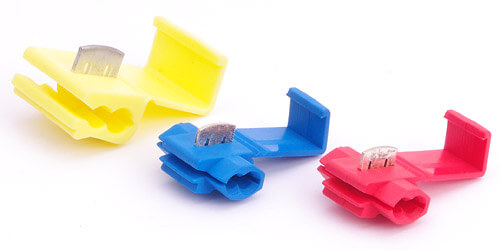
As for the drawbacks of the latches, the main one is the limited conditions of use - the cross section of the cores should not exceed 6 mm2. In turn, for a home wiring of such a cross section will be enough even to connect a powerful electric stove.
Such connectors are also called "Scotchlocks." You can learn more about what Scotchlocks are and how to use them from our separate article: https://my.electricianexp.com/en/skotchloki-dlya-soedineniya-provodov.html.
Video instruction for using the latch for branching the wire without cutting:
Polyethylene terminal blocks
A more obsolete way of branching the wire is the use of terminal blocks (they are also called polyethylene terminal blocks). Compact terminal blocks use is not recommended, because in this case, one cannot do without cutting and rupturing the main core. In addition, the terminal block also has disadvantages such as poor tightness and the need to periodically tighten the clamp screw, especially if the conductor is aluminum. As a result, you do not get any important advantages during splicing and at the same time you get several serious drawbacks.
Grandfather twist
Well, the last method of branching wires that can be used is to twist a new line with a passing trunk without additional soldering or welding. In this case, it is first necessary to strip the insulation of the conductors, after which the branch line should be screwed onto the trunk line (as shown in the picture).
We draw your attention to the fact that when creating a twist, it is forbidden to connect aluminum and copper conductors. Conductors should be made of one metal. According to clause PUE 2.1.21. (Chapter 2.1 PUE) twisting can not be done at all - all connections must be soldered, welded, crimped or fixed with clamps or terminal blocks. Therefore, for branching from the wire, use the above methods or solder such twists. Read more about how to do twisting in the article: https://my.electricianexp.com/en/kak-pravilno-sdelat-skrutku-provodov.html.
Here, in fact, we examined the most popular methods of branching wires without tearing and cutting. Now you know how to make a quality merging of two power lines. Our advice - use the piercing clamps, which among all the options are the most trusted!
Similar materials:




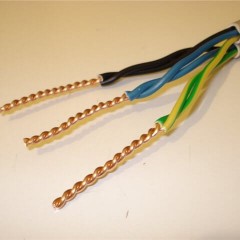
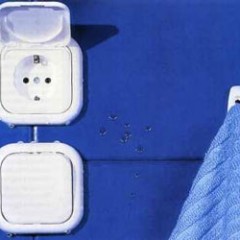


Twisting is better not to drink
Why?
To quickly disconnect if necessary and leave no traces
In our ABC Electro I was laughed at by the question: "is there a" nut "that allows you to make the same 2.5mm bend from a 2.5mm cable?" To which they answered me: “walnut” is intended only for connecting a cable of at least 4 squares without any taps!
I have a problem in the country: I need to make a 2.5 branch from the cable 2.5 to install outlets through the machine. Scotchlocks are doubtful about the thinness of the piercing plate.